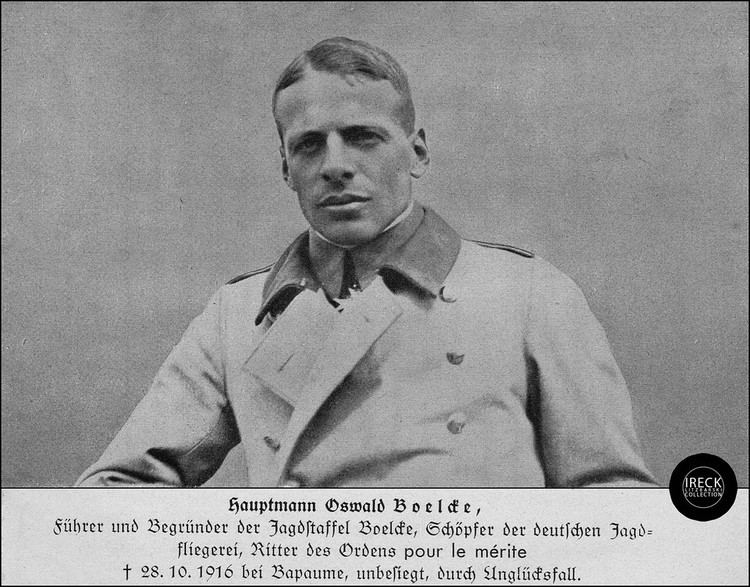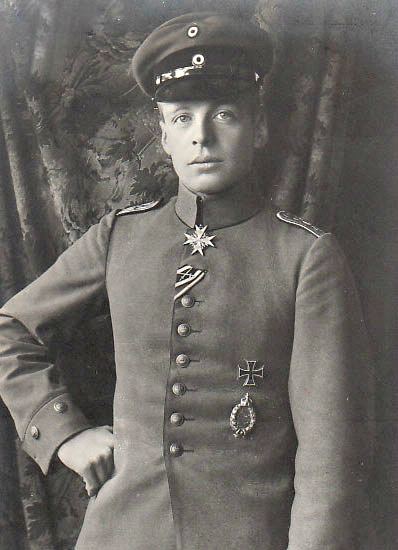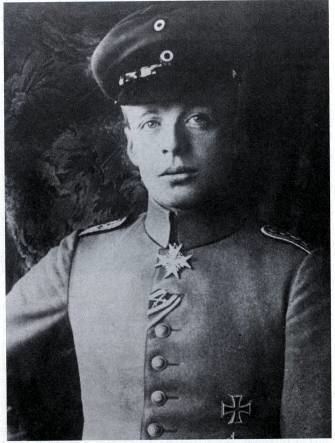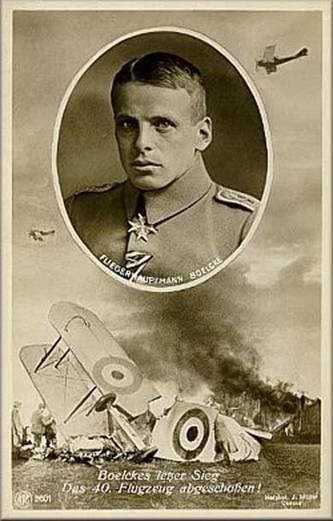Years of service 1911–1916 | Service/branch Luftstreitkrafte Name Oswald Boelcke | |
 | ||
Books An Aviator's Field Boo, An Aviator's Field Book, Richthofen and Boelcke i, An Aviator's Field Boo | ||
The death of oswald boelcke
Oswald Boelcke ( [ˈbœlkə]; 19 May 1891 – 28 October 1916) was a German flying ace of the First World War and one of the most influential patrol leaders and tacticians of the early years of air combat. Boelcke is considered the father of the German fighter air force, as well as the "Father of Air Fighting Tactics". He was the first to formalize rules of air fighting, which he presented as the Dicta Boelcke. While he promulgated rules for the individual pilot, his main concern was the use of formation fighting rather than single effort.
Contents
- The death of oswald boelcke
- Tribute to oswald boelcke father of air fighting tactics
- Early years
- 1914
- 1915
- Boelcke wins the ace race
- The Gentleman Pilot letter delivery
- Creation of Jasta Boelcke
- Robert Wilson
- Death
- Legacy
- Orders and medals
- In popular culture
- References

The German flying ace Manfred von Richthofen (The Red Baron), had been taught by Boelcke and continued to idolize his late mentor long after he had surpassed Boelcke's tally of victories.

Tribute to oswald boelcke father of air fighting tactics
Early years

Oswald Boelcke was born on 19 May 1891, in Giebichenstein, the son of a schoolmaster. His father's first teaching job had been in Argentina from where the family had recently returned. Boelcke's three elder siblings were born in Buenos Aires.

His family name was originally spelt Bölcke, but Oswald and his elder brother Wilhelm dispensed with the umlaut and adopted the Latin spelling in place of the German. The pronunciation is the same for both spellings.
Boelcke's family moved to Dessau, the capital of the Duchy of Anhalt when he was young. As a youth he caught whooping cough; in order to build up his stamina, he became increasingly involved in playing sports but retained a tendency towards asthma throughout his life. Among his athletic pursuits were swimming, tennis, rowing, and gymnastics. However, he never did become very large; in later life, he was described as being about 5 feet 7 inches tall.

Oswald Boelcke was studious as well as athletic, excelling at mathematics and physics. His father was a nationalist and a militarist. Under his influence, the 13-year-old Boelcke had the audacity to write a personal letter to the Kaiser requesting an appointment to military school. His wish was granted, but his parents objected and he did not attend Cadet School. Instead he attended Herzog Friedrichs-Gymnasium, graduating Easter 1911.

After leaving school he joined Telegraphen-Bataillon Nr. 3 in Koblenz as a Fahnenjunker (cadet officer) on 15 March 1911. After attending Kriegsschule in Metz, Alsace-Lorraine, where he took his lieutenant's exam, he received an officer commission in the Prussian Army a year later. Since Boelcke had Abitur, his commission was pre-dated 23 August 1910, making him senior to the other new lieutenants in his battalion.
1914

In mid-1914, Boelcke transferred to what was then known as the Fliegertruppe. His flight training took place from May to August at the Halberstädter Fliegerschule. He passed his final pilot's exam on 15 August 1914. He was then immediately posted to active duty. Due to the influence of his elder brother, Hauptmann Wilhelm Boelcke, Oswald was initially posted to Feld-Fliegerabteilung 13 (FFA 13, Aviation Section 13), of which Wilhelm was a member. Boelcke won an Iron Cross Second Class for flying 50 missions with this unit, in company with his brother. They were such a successful team they aroused antipathy in other members of the section. As a result, Wilhelm was transferred away from his brother.
1915
At his own instigation, Boelcke transferred to FFA 62 in April 1915 which was based at Douai. This was a reconnaissance unit using LVG C.II two-seater aircraft to observe and adjust artillery fire.
In July 1915, Boelcke, Max Immelmann, Otto Parschau and Kurt Wintgens, were allowed to fly three of the five prototypes of the Fokker E.I aircraft, the Fokker M.5K/MG. These types were fitted with a synchronized forward-firing air-cooled Parabellum machine gun slaved to a gun synchronizer that prevented accidentally shooting the Fokker's propeller. Leutnant Parschau had been the first person of this group to work with Fokker in developing the Eindecker as a prototype fighter, and received the first example of the M.5K/MG, with military serial "E.1/15", with Boelcke getting the third example, "E.3/15", which he first flew on 7 July. Use of the type by operational units was restricted; the provision being that they were to be flown when pilots were not flying reconnaissance missions in their two seaters. They were considered so revolutionary that orders had been given that they wouldn't be risked over enemy lines for fear of capture.
Wintgens, flying the final M.5K/MG "E.5/15", made the first victory claim with the new aircraft, on 1 July 1915, but it went unconfirmed because it fell behind French lines. Historians have since identified the aircraft and crew as being a two-seater Morane-Saulnier Type L "parasol" monoplane crewed by Capitaine Paul de Peuty and Sous-Lieutenant de Boutiny, who were both wounded.
In the meantime, while flying a two-seater, Boelcke's observer (Leutnant Heinz von Wǘhlisch) shot down their first enemy aircraft on 4 July 1915, in a protracted running fight between reconnaissance craft. Boelcke landed near the French aircraft's wreckage and verified the death of the crew. On that same day, Wintgens had another unconfirmed win over a Morane Type L, and with a July 15 victory over yet another Type L "Parasol", finally got official credit for the third aircraft he had downed in his military career as his first observed, "confirmed" victory.
Boelcke won his first individual aerial combat while flying in E.3/15 on 19 August 1915. Just nine days later, he was a hero on the ground. He dived into a canal near his aerodrome, fully clothed, and rescued a drowning French boy, Albert DePlace. The child's parents wanted Boelcke to be awarded the French Legion d'Honneur; instead, he received the Prussian Lifesaving Medal.
On 22 September, Boelcke was moved to Metz, joining the Brieftauben-Abteilung-Metz unit but was moved back to FA 62 in December. He downed four more enemy aircraft before the end of the year. Max Immelmann had scored his first victory just before Boelcke's first, on 1 August with an early production E.I, E.13/15. He and Boelcke had a "horse race" of victories, with first one rival leading, then the other, as they left Wintgens behind. The deadly effect of the new aircraft on aerial combat was beginning to be referred to as the Fokker Scourge. On 1 November, the day after his sixth victory, Boelcke became the first German pilot to win the Royal House Order of Hohenzollern. Immelmann duplicated the feat six days later.
By the end of 1915, Immelmann had seven victories, Boelcke had six, and Wintgens and Hans-Joachim Buddecke had three.
Boelcke wins the "ace race"
Boelcke had three more victories in January 1916; Immelman had two, in the same month, Boelcke and Immelmann also were the first German fliers to be awarded the Pour le Mérite, Germany's highest military medal, as each pilot achieved the required eight aerial victories to earn it on the same day, 12 January.
In March 1916, Boelcke emerged from a stay in hospital for intestinal problems, and upon complaining he was stationed too far from the front at Jametz, was given permission to use the forward airfield at Sivry near the Verdun offensive. Boelcke then connected a front line observation post to the airfield, and thus established the first tactical air direction center. He was made leader of the newly formed Fliegerabteilung Sivry and led them in action over Verdun. This unit of six fighter pilots was the precursor of the Jasta German fighter squadron units. The new fighter unit was stationed near Stenay, which was the headquarters of Crown Prince Wilhelm. A friendship developed between the Crown Prince and the ace.
The ace race was still on; Boelcke became the first Überkanone with his 10th victory on 12 March; the following day, even as he scored, Immelmann scored one of the first double victories of the war to tie it up at 11 all. The dead heat lasted for a week; on 19 March, Boelcke used his usual tactics of pointblank fire to kill the enemy pilot and saw off his Farman's wing with machine gun fire, for win number 12. Immelmann telephoned to congratulate him and ask him for an opportunity to catch up; Boelcke jokingly offered him a week's grace. Boelcke's victory two days later may be seen as symptomatic of his disregard for Immelmann.
By this time, the increasingly-obsolescent Fokker E.III was being replaced by newer Halberstadt single-gun biplane fighters, and twin-gun armed Albatros biplane aircraft, both types fitted with synchronized guns. The French had countered the "Fokker Scourge" with fast new Nieuports; the British also countered, with pusher aircraft that could fire in their direction of flight without need of synchronizing gear. Boelcke focused on developing his own counter methods: flying in tight formations, accurate gunnery in combat and remaining within his own German lines.
By 18 May, Boelcke established his lead over Immelmann for good, 16 victories to 15, to become the highest scoring ace in the war up to that time.
After Immelmann was killed on 18 June 1916 after his 17th victory, Boelcke, who then had 18 victories, was left the preeminent ace of the war. Kaiser Wilhelm II ordered Boelcke grounded for a month to avoid losing him in combat soon after Immelmann. He had become such an important hero to the German public, as well as such an authority on aerial warfare, that he could not be risked. Given a choice between a desk job and a tour of the Middle East, Boelcke downed a Nieuport over Douaumont on 27 June and reported to headquarters. Boelcke was detailed to share his expertise with the head of German military aviation. The German air force was being reorganized from the Fliegertruppe into the Luftstreitkräfte in mid-1916; this reorganization was inspired by Boelcke. At this time, Boelcke codified his Dicta, which was a distillation of his successful tactics. He also shared his views on creation of a fighter arm, and the organization of fighter squadrons.
Boelcke was sent on a tour of the Balkans. He transited Austria to visit Turkey. On the return trip he visited Bulgaria and the Russian Front. Along the way, he interviewed pilots. Boelcke was visiting Wilhelm in Kovel when he received a telegram from Hermann von der Lieth-Thomsen appointing him to raise, organize and command Königlich Preussische Jagdstaffel 2.+
The "Gentleman Pilot" letter delivery
On 5 January 1916, Boelcke shot down a British B.E.2c biplane of No. 2 Squadron crewed by Lt William Somervill and Lt Geoffrey Formilli. He maintained contact with the two men when they were hospitalized and went to great lengths to deliver a letter Formilli wrote, informing people he was still alive. Formilli wrote, " PS. It was Boelcke who brought us down,” and Boelcke's kindness led to the newspaper comment that he was a "Gentleman Pilot". The letter was auctioned by Formilli's family in 2012.
Creation of Jasta Boelcke
He was given permission by the head of German aviation, Feldflugchef (Aviation Chief of Staff) Oberstleutnant Hermann von der Lieth-Thomsen, to choose his own pilots to form a fighter squadron. Along the way, he interviewed pilots. Among his first selections upon his return were Manfred von Richthofen and Erwin Böhme.
Boelcke was appointed commander of his hand-picked group of pilots on 30 August 1916. Three squadrons were the first ones founded, on 10 August 1916, but among them, Jagdstaffel 2 became the premier German unit. It ended the war with 20 aces among its members, a total of 336 victories, and a casualty list of only 44. In the beginning, however, Boelcke started with only the empty buildings vacated by FFA 32 in the Vélu Woods. As of 27 August, the fledgling jasta had three officers and 64 other ranks on strength, but no aircraft. But as of 8 September, there were eight pilots on board, including Manfred von Richthofen and Erwin Böhme. Three days later, Böhme noted he was pushing for permission to use his castoff Halberstadt, since Boelcke had a Fokker; there seemed to be four aircraft in the squadron by then. On 16 September, Boelcke's new squadron received five new Albatros D.Is for the pilots, and an improved Albatros D.II for the Staffelfuhrer. Boelcke promptly put the new fighters in the air on the first-ever fighter unit effort to gain local air superiority. At 1300 hours 16 September, Boelcke and five of his pilots took off; they intercepted a British bombing raid on Marcoing Railway Station. While Boelcke held aside, his five tyros bounced a British formation of 14 planes, broke it up, and shot down two. The master himself added another.
Boelcke shot down 10 Royal Flying Corps aircraft in his first month with Jasta 2, September 1916. He would fly a solo mission in the morning and return to his "cubs", who would ask if he had scored again. He would ask them if his chin was black with burnt cordite from his machine guns' breech. If it was, he had fired his gun and scored. However, in contrast to his freebooting style, his pilots always flew in disciplined formations in practice, and he repeatedly drilled them in his tactics. Among them were his famed combat rules, called "Boelcke's Dicta", which were the first systematic analysis of air combat and continued to be applicable through World War II. Despite his run of personal successes, Boelcke's attitude is best expressed thus, in his own words: "Everything depends on sticking together when the Staffel goes into battle. It does not matter who actually scores the victory as long as the Staffel wins." He not only preached this doctrine to his own "cubs"; he proselytized throughout the Luftstreitkräfte. He wrote upon his ideas, sketched them out and delivered them in person to other aerodromes.
Robert Wilson
After being released at the end of the war, Capt Wilson described his encounter with Boelcke as 'the greatest memory of my life, even though it turned out badly for me.'
Death
Boelcke set out on 28 October 1916 for his sixth sortie of the day with his two best pilots, Manfred von Richthofen and Erwin Böhme, and three others. Before they had set out on their attack, Boelcke, rushing to get ready, failed to strap on his safety belt properly. The patrol eventually led them into a dogfight with single-seater DH.2 fighters from No. 24 squadron RFC.
In the ensuing dogfight, Boelcke and Böhme, unaware of each other's presence, closed in on the same aircraft, flown by Captain Arthur Knight. Von Richthofen dived in on the flight path of that very same aircraft; he was chasing the other DH.2, piloted by Lieutenant Alfred Edwin McKay. Boelcke swerved to avoid a collision with the interceding aircraft. Böhme's landing gear brushed Boelcke's upper wing. As the fabric peeled off the upper wing of his aircraft, Boelcke struggled for control. He and his aircraft fell out of sight into a cloud. When it emerged, the top wing was gone. However, Boelcke made a relatively soft crash-landing. The impact seemed survivable. However, his lap belt did not restrain him, and he never wore a helmet when he flew.
Minutes later, the pilot's lifeless body was pulled from his smashed Albatros D.II. The great Oswald Boelcke, victor of 40 aerial engagements, was dead at age 25.
Both Böhme and Richthofen left descriptions of the catastrophe. Richthofen's account, from his memoirs:
Böhme also remarked, "Why did he, the irreplaceable, have to be the victim of this blind fate, and why not I?" Böhme, blaming himself for Boelcke's death, had to be talked out of committing suicide. As the Fatherland mourned, Boelcke was buried with full honors at his aerodrome in Cambrai. The Royal Flying Corps dropped a wreath a day later over Jasta 2 which read, "To the memory of Captain Boelcke, a brave and chivalrous foe."
In honor of their great leader, Jasta 2 was officially named "Jasta Boelcke" on 17 December 1916, a name the squadron still bears to this very day. Erwin Böhme was killed exactly one year, one month, and one day after his collision with Boelcke.
In the end, Boelcke had died because of a violation of one of his own dicta, which mandated never to close in on a single combatant when others are also pursuing it.
Legacy
Boelcke' life was commenrated in October 2016, the 100th anniversary of his death.http://www.dessau.de/Deutsch/Dessau-Rosslau/Aktuelle-Beitraege/100-Todestag-von-Os-04696/
Orders and medals
Prussian / Imperial German
Duchy of Anhalt
Kingdom of Bavaria
Other
In popular culture
Jeff Shaara's To the Last Man: A Novel of the First World War is a novel of World War I and especially the flying aces such as Oswald Boelcke. He was portrayed by Peter Masterson in the 1971 movie, Von Richthofen and Brown.
